Benitoite
The Benitoite Gem Mine has been featured on the Travel Channel's television show "Finding Cash and Treasures" as well as other television programs.
Benitoite
( pronounced "ben-ee-toe-ite" )
If you are not a rockhound, mineral collector, or connoisseur of rare gemstones, then you may have never heard of Benitoite.
This amazing crystal was discovered in 2007 at the Benitoite Gem Mine. This piece of rough weighed in at a wopping 34.4 carats. It was faceted into 4 stones, the largest of which is a beautiful flawless 8.06 carat gemstone (pictured below).
It is the 4th largest flawless benitoite ever cut and the largest flawless benitoite available for sale on the open market. This amazing gemstone is on consignment. If you wish to see it and a brief video of this gemstone, please visit my Loose Benitoite Gemstones page.
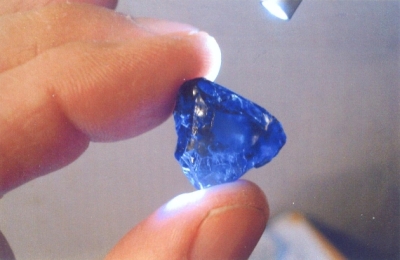

The mine is not dead as some would have you believe. This 10" plate of facet grade benitoite crystals was produced from a large specimen found in September 2011. This plate was cut and etched from a vein running through a mud encrusted 100 pound boulder. This plate sold in Tucson 2012 for 5 figures.

Benitoite is the state gemstone of California. It is without a doubt, the rarest Gemstones in the world! Gem quality stones and unbelievable mineral specimens can only be found one place on earth, a small 40 acre parcel of land in the Diablo Mountain Range of San Benito County California. The mine has gone by many names over it's 106 year history. It's original name was the Dallas Mine, then it was called the Cole Mine for a while, then The Benitoite Gem Mine, The Gem Mine and it is now called the California State Gem Mine. Benitoite was first discovered here in 1907. It was first thought to be sapphire or blue diamond due to it's deep blue color and amazing internal fire. After samples were sent to the University of California for examination in the early 1900's, it was discovered to be a new mineral. Up until the time of discovery, science knew that crystal forms such as these were mathematically possible, but they had never been discovered, and no others have ever been found. Although microscopic crystals have been discovered in a few other locations, the Benitoite Gem Mine is the only place on earth that gem and specimen quality benitoite has been found.
Benitoite has the rarest form of crystal structure in the world. It belongs to the Hexagonal System, it's Class is Ditrigonal -Dipyramidal. It's light dispersion or internal fire is greater than that of diamond. Dispersion is the splitting up of white light into its individual wavelengths, what we see as colors. A benitoite that has good clarity, color and cut will show greater fire than a diamond.
With the color of the most valuable tanzanite, it is easy to see why it is so valued. Gem quality Benitoite can be worth more than Diamonds, Sapphire, Ruby, Emerald or Tanzanite. A clean, rare 1 carat cut benitoite sells between $6500 and $8500, depending on color, cut and clarity. The cost increases greatly as the size of the cut stone increases due to the rarity of large facet grade crystals. Current market pricing of clean, good color, and well cut faceted benitoite over 2 carats, is $10,000 per carat. Even uncut, rough stones and good mineral samples in matrix can run in the thousands. It is one of the only gemstones that is naturally deep blue in color, not needing heat or any other treatment to achieve it's color. It can be found in differing shades of blue, violet, white, clear, and on very rare occasions very pale pink, but the Deep Blue color is the most desirable. Science still cannot identify exactly what gives benitoite it's amazing color, and scientists have been unable to duplicate or replicate benitoite's crystal growth or fluorescent nature.
Some examples of Crossite Included Benitoite crystals
(known as Stoneys or Rockys)

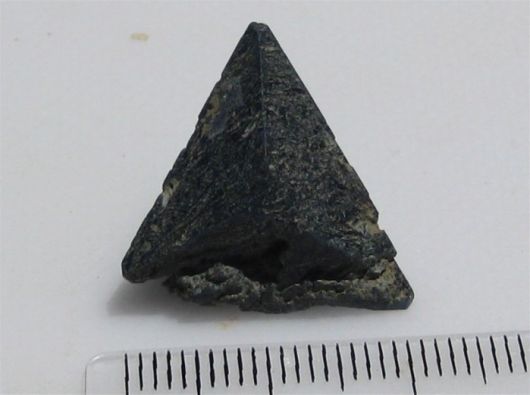
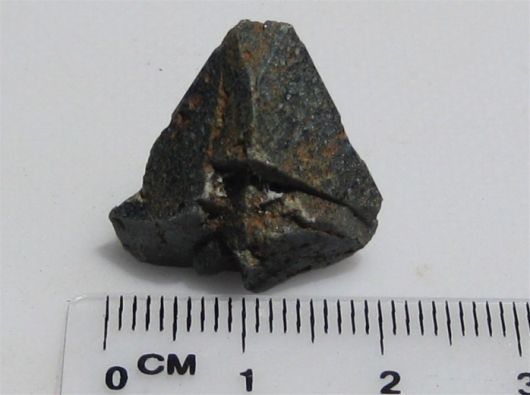
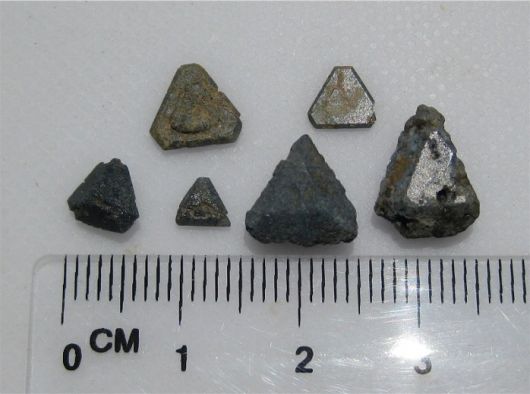
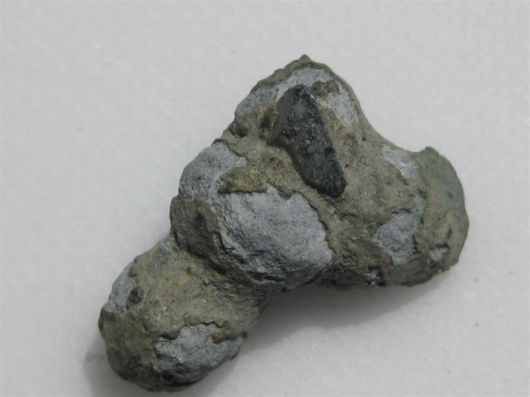
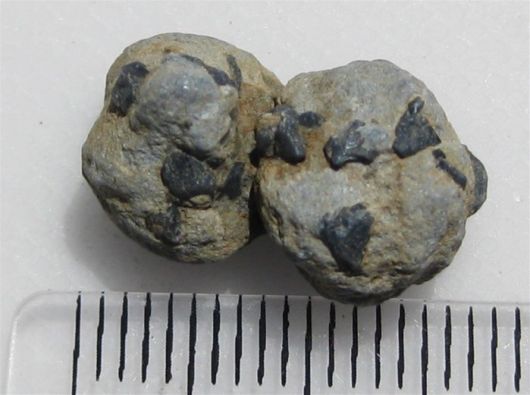
Some examples of Gem Quality Benitoite Crystals
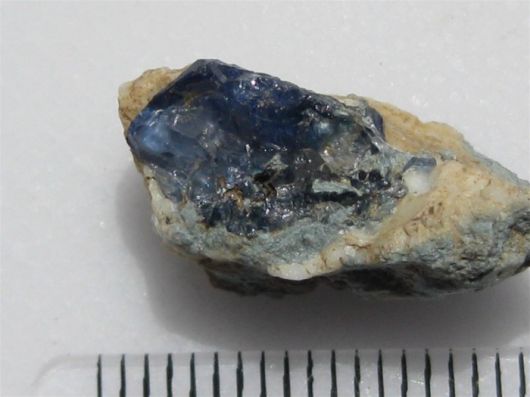
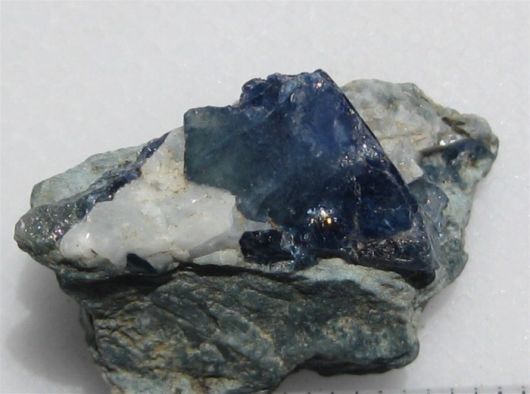
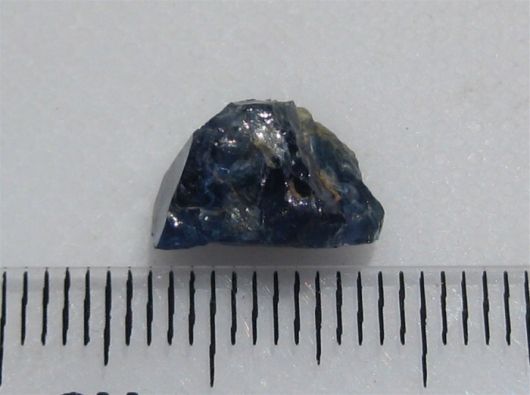
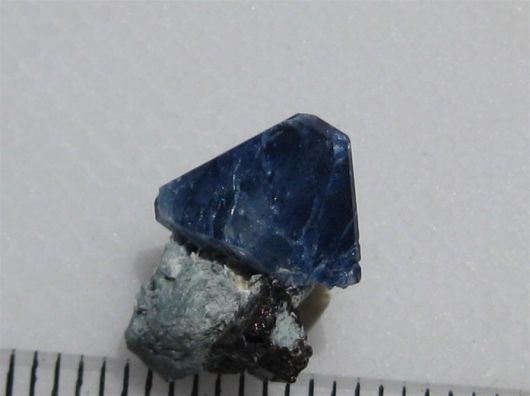
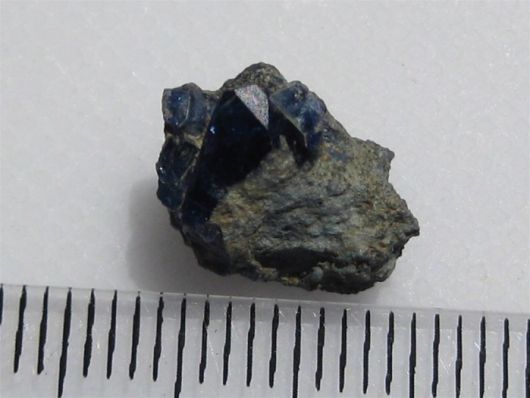
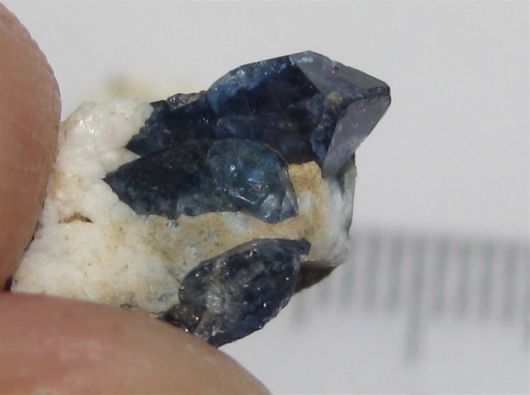
These are all examples of what you too might find!
Benitoite is found with a few other rare minerals such as black-red Neptunite, snow white Natrolite and brown-yellow Joaquinite. The only source of this rare combination occurs at San Benito, California. They are formed in fractures of a serpentine rock from hydrothermal solutions. These solutions contained a number of unusual elements such as barium, titanium, fluorine, iron, cesium, niobium, manganese and lithium in relatively high concentrations. How such a solution occurred and what other conditions caused the crystallization of these rare minerals is still not well understood. It's truely unique Hexagonal - Ditrigonal Dipyramidal ( triangular shaped ) crystals, are unlike anything on earth. The rare clusters of blue benitoite and black neptunite on top of a crust of white natrolite produces a truly fantastic and a one of a kind mineral combination that is a must have for a serious mineral collector.
The following is a list of minerals that have been found at the Benitoite Gem Mine; Actinolite / Tremolite, Analcime, Andradite, Apatite, Baoite, Bario-Orthojoaquinite, Benitoite, Calcite, Chrysocolla, Covellite, Crossite / Glaucophane, Digenite, Djurleite, Feldspar, Fresnoite, Joaquinite, Jonesite, Natrolite, Neptunite, Quartz, Serandite, Stilpnomelane.
Once you have found a nice raw specimen, many would like to properly clean them or acid etch them to see it there might be more crystals within and under the natrolite. If you go to our How To Page, you will find a guide to etching a benitoite specimen as you follow me while I walk you thru a specimen I etched.
This specimen below is a good example of what can hide under the natrolite.


Benitoite also fluoresces a beautiful blue color under shortwave UV light. It is one of the easiest ways to search for this mineral and makes it a real prize among fluorescent mineral collectors.
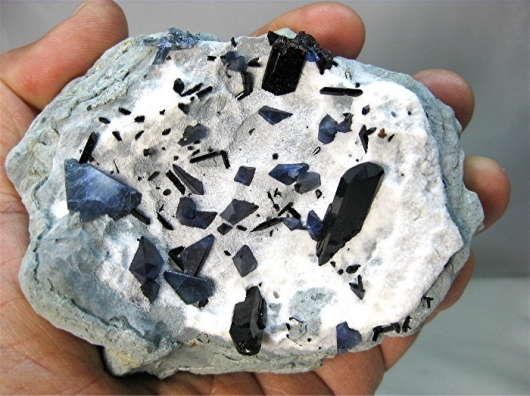

Current Mine Status (Closed to the Public)
Although commercial mining is no longer being conducted at the mine, a few years ago, the present owner Dave Schreiner purchased the mine with the sole purpose of opening it up to the public for the first time in it's 100 year history. People could now dig thru the old mine dumps, tailings and virgin ground to try and find their own treasured jewels. Unfortunately that was short lived and now with the EPA's / BLM closure of the area, there is no way of knowing if anyone will ever get the chance again to dig at the mine.
Some people that deal in Benitoite will have you believe that the benitoite mine has been all worked out or that the known benitoite specimen universe is finite, this is not completely true. This is basically a sales ploy to get you to purchase what they have for sale. I like to say that the mine is just sleeping! Although the originally discovered vein was completely worked out, know one knows for sure that there is not more vein to be found. The previous mine owners did not stop mining because there was nothing left to find, but due the lack of water 6 months out of the year, and thick mud / dirt clods that take forever to break down at the mine, it was no longer economically feasible to continue mining operations on such a large scale.
Previous owners of the mine throughout it's history, processed a lot of material very quickly, mainly looking for gem quality crystals. In doing so, a lot of material was overlooked. That is why great specimen pieces and facet rough are still being found today.
Take for example all of the specimens and facet rough still being found or the 34 carat piece of rough found by the owners in 2007. That piece was faceted into 4 stones, the largest being an 8.05 carat flawless gemstone (see top of this page). I have personally found a piece that after being etch, yielded several over 2 cm. gem quality crystals. If everything at the mine had been gone thru as some would have you believe, then pieces such as these would not be there to find. In addition, in it's 105 year history, none of the previous owners searched for benitoite using shortwave UV. It is a much more productive way of finding exposed benitoite than gravity or magnetic separation. Will you find a big plate worth ten's of thousand's of dollars, the possibility is still there. However there are still specimens and pieces of rough being found that are worth hundreds if not thousands of dollars.
I can't say this enough to people I meet, there is still a good amount of specimen quality and gem quality benitoite to be found. Just look at what we have for sale, 99% of all the benitoite I have for sale, I personally found. You too have a chance to find your own benitoite specimen or gem.
There are no longer any public collection trips to the mine.
However the Benitoite Mine Fee Dig has been in operation since 2009. Many find specimens and crystals have been discovered people all the time.
The Benitoite Fee Dig is open Saturdays by reservation only. For more information go to www.benitoitemining.com
For more information, you can email me or contact the mine owners directly, Dave or John Luke Schreiner at (833) GEMHUNT / 436-4868
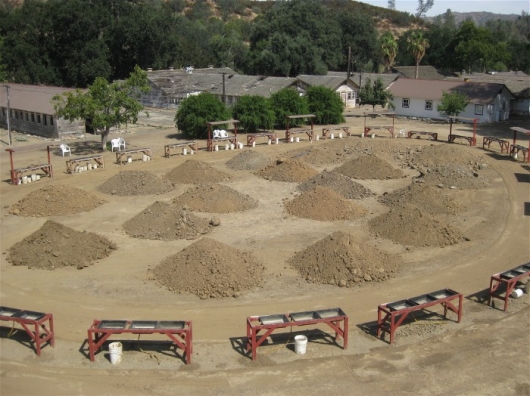
Benitoite Fee Dig
The Fee dig is presently open Only Saturdays and will require a reservation.
All reservations require a phone call for confirmation.
(833) GEMHUNT / 436-4868
Opening time is 9AM
Here you can screen, wash and even blacklight your material all day long. Closing time is around 3:00 pm.
Cost is $140 per Adult
$75 for children 12 and under
Amazing Benitoite Find
This story is a perfect example of why I tell everyone, that just because a piece of matrix with natrolite has no signs of benitoite, that does not mean there's not benitoite present! Hopefully this story will encourage others in your hunt for benitoite!
Whenever things are a little slow, I usually take a few pieces of benitoite potential matrix and throw them in some acid to see if any signs of benitoite show up. These pieces are usually crossite / schist with natrolite on top or running thru the pieces with no fluorescence at all.
During this past year I did this, and one piece out of about a dozen I was soaking at the time caught my eye. So I put the others aside and continued on this one piece. This piece of crossite was about 6 inches long by about 4 inches thick. It had a vein of natrolite running thru it. The natrolite did not appear to be a thick vein at first, but there was also a large amount of what Dr. Louderback ( the person who named benitoite and discovered that it was a new mineral) called green natrolite in his papers. This is natrolite that absorbed some of the green colored crossite around it while forming. It does not dissolve in acid like natrolite does, but it does remove very easily in acid. In the past, most of the super gem quality crystals I have found, were found in and around this "green natrolite".
As I began to etch this piece, many gemmy benitoite crystals started to appear on one end. Most were under 1 cm in size, but the shear number of smaller gem quality crystals was amazing. So I carefully over a months time worked on this end of the specimen, carefully etching. This piece had dozens of facet grade crystals on it, but this story is really not about this end of the specimen. The best is yet to come.
One thing struck me as odd. Down on the other end of the specimen a large neptunite had appeared. Near it was a very thin vein of benitoite that began to show up which ran thru the back of the piece for about 2 inches. For a while I paid no attention to this thin vein, since I had never had any luck chasing out such a thin vein. So after about a month of etching, I took the piece with me when I went to see the mine owner. He was amazed to see what was showing, but also suggested I try and follow the vein.
Well, after about a month, I started to etch the other end of this piece and this is where the story takes an amazing turn. This end was still pretty thick, but within 2 days what appeared to be the large face of a crystal began to appear, and it was super clean. So I took my time and etched very slowly over the next week. The amazing result is what this story is all about.
I have split the specimen into 2 pieces now. The upper portion, and the first group of crystals found are one specimen now. This story is only about the part of the specimen that only originally showed a thin benitoite vein.
The find...............
Well besides the large neptunite, 2 amazingly large benitoite crystals appeared. One measuring 2.0 cm by almost 2.0 cm tall by a whopping 9 mm thick. The other crystal, even larger, 2.2 cm by approximately 1.7 cm tall, by 8.5 mm thick.
These two massive crystals are super gem quality crystal. The larger one is more clear to light blue, the other is clear to a very dark blue. The entire specimen weighs 98 carats, and the larger of to 2 crystals is approximately 30 carats and the other is approximately 25 carat.
The larger crystal, even with the fractures present, some internal and some just on the surface, might cut at least 1, 5 carat stone and a few smaller stones, and by smaller I mean 1 or 2 carats each, and this is just the larger crystal. The other I have not really even considered, but a few stones over 2 to 3 carats each might be possible. This carat size information, is just used for example, to show the crystals clarity, since this specimen will not be chopped up.
I will not have these cut. I am a purist, if the crystal is not damaged, it does not get cut. This is worth much more as a specimen, since any specimens that even came close to crystals such as these has long ago been cut up and faceted already.
Although I enjoyed this specimen very much in both etching it and admiring it, I was made an offer for the specimen that I could not refuse.
It has been sold and is now being admired by another.







